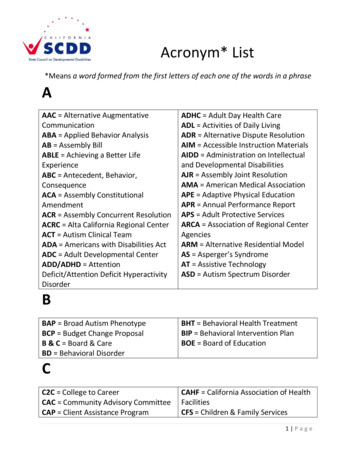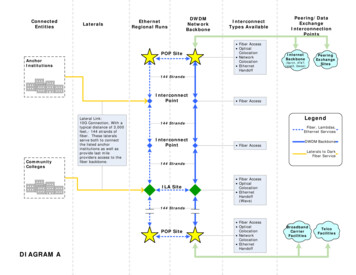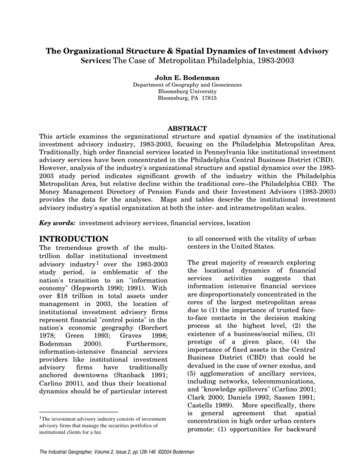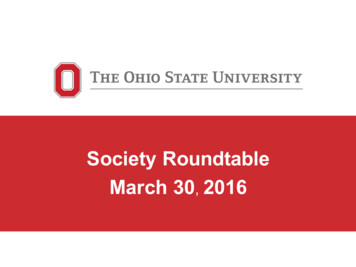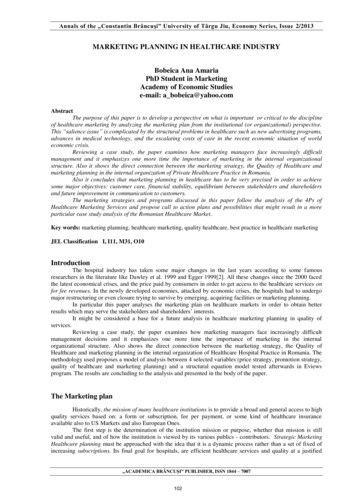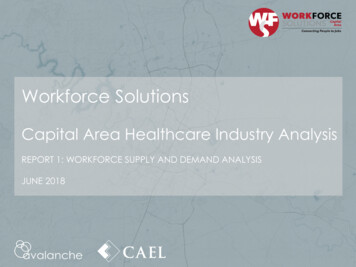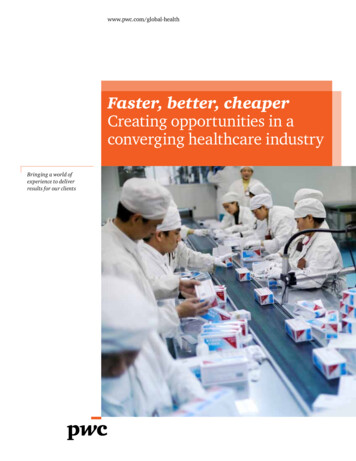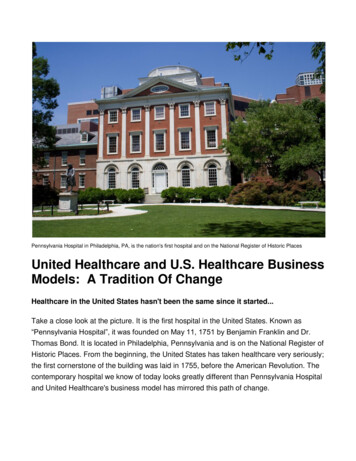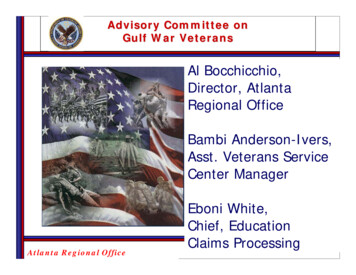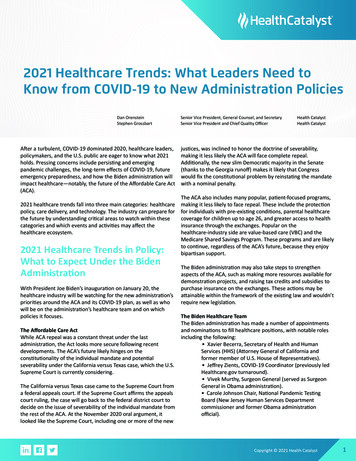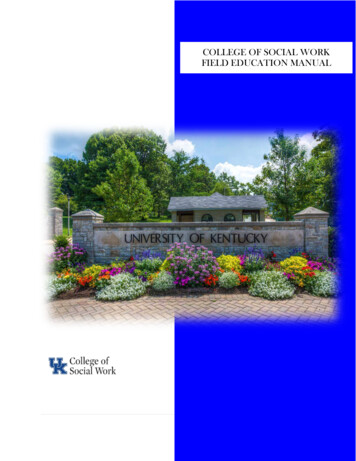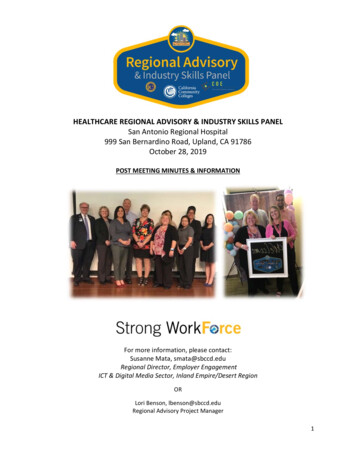
Transcription
HEALTHCARE REGIONAL ADVISORY & INDUSTRY SKILLS PANELSan Antonio Regional Hospital999 San Bernardino Road, Upland, CA 91786October 28, 2019POST MEETING MINUTES & INFORMATIONFor more information, please contact:Susanne Mata, smata@sbccd.eduRegional Director, Employer EngagementICT & Digital Media Sector, Inland Empire/Desert RegionORLori Benson, lbenson@sbccd.eduRegional Advisory Project Manager1
TABLE OF CONTENTSBackground, Mission, Goals2Agenda3Industry Advisors (Panelists)4Industry Skills Panel Questions & Responses9Breakout Group Questions & Responses11LinkedIn & Photos18Labor Market InformationEmployability Skills Survey ResultsAttendance‐ BACKGROUND ‐The Regional CTE Advisory Pilot Project is funded by the Inland Empire/Desert Region Consortium'sStrong Workforce Program. This project answers growing interest and requests to provide a “regionaladvisory format”, accessible to all community colleges, ROP's, and K‐12's in our diverse region, whilealso meeting Perkins and other grant requirements. In partnering with CRY‐ROP, a dynamic advisoryformat has been developed. In collaboration with Inland Empire Economic Partnership (IEEP), RegionalCTE Advisory Communities are being established, with meetings facilitated throughout the Region. Thisformat allows for a purposeful gathering of educators and industry advisors, sharing their knowledgeand expertise on a regional basis, without over‐taxing industry advisors with multiple meetingsthroughout the year.‐ MISSION ‐The mission of this project is to promote student success and to innovate for jobs and the economy: togather community stakeholders sparking innovative, invigorating conversation between educators andindustry professionals. Educators discover the latest business and entrepreneurial trends, industrydemands, employment skills needed, and training practices. Industry partners gain an understandingregarding the importance of their expertise and advisement, in areas such as: updating curriculum, newcoursework and certificates, equipment and programs needed, thus, benefitting communitystakeholders, students, individuals, and businesses.‐ GOAL ‐The overarching goal of this project is to enhance career education and to meet the demands of theeconomy and the labor market: to evaluate, strengthen, and revise curriculum to ensure alignment fromeducation to employment. Preparing a highly‐skilled workforce, meeting today’s new and ever‐changingindustry needs, is at the core. More students will possess valuable skills, earn meaningful certificates,and participate in internship opportunities, leading to living‐wage employment in their chosen field ofstudy. Ultimately, career pathways will improve and high‐demand jobs will be filled.2
HEALTHCARE WEST AGENDASPECIAL THANKS TO:San Antonio Regional Hospital999 San Bernardino Road, Upland, CA 91786Aita AuditoriumMonday, October 28, 20198:45 am – 2:00 pm8:45 amRegistration, Networking, Light Continental9:00 amWelcome & Introductions: Lori Benson, Project Manager; Jason Cordova, Inland EmpireEconomic Partnership; Wendy Deras, Regional Director of Employment Engagement forHealth, Desert/Inland Empire9:15 amLewis‐San Antonio Healthy Communities InstituteTerisha Gamboa, Healthy Communities Specialist9:30 amLabor Market Information, Michael Goss, Center of Excellence, Regional Director10:00 amIndustry Skills PanelModerator: Angelica BaltazarExecutive Director, Lewis‐San Antonio Healthy Communities Institute11:00 amPanel Q & A ‐ Ask the Experts11:30 amLunch with Colony High School and Alta Loma Health Academy Students12:30 pmCommunity College Updates12:45 pmPathway Development Breakout Groups by Sub‐sector1:30 pmGroup Report‐outs2:00 pmAdjourn, thank you for attending!Follow Us on land Empire Economic PartnershipConsortiumInland Empire/Desert Region@IEEP@cte iedrcAdvanced ManufacturingICT/Digital Media@DSN AlanEnergy/Construction/utilities@DSNsmata1@jon cafferyBusiness & althDSN3For post‐meeting communication, please join this LinkedIn Group: http://bit.ly/HealthRACGroup
HEALTHCAREPlease Meet Our Esteemed Panel of Industry Experts:PANEL MODERATORAngelica Baltazar, MSW, ExecutiveSan Antonio Regional HospitalLewis‐San Antonio Healthy Communities Instituteabaltazar@sarh.orgAngelica Baltazar is the Executive Director of the Lewis‐San Antonio Healthy Communities Institute atSan Antonio Regional Hospital. She joined San Antonio after a career as a health and human servicesprofessional with roles in social work, public health, local government, and most recently, technology.She is experienced across many sectors in both for profit and not‐for‐profit organizations includingeducation, community organizations, faith‐based organizations, and healthcare. She also bringsexperience in providing technical assistance to local governments giving specific recommendations forpolicy and environmental strategies to improve residents’ health. Angelica’s experiences in both thepublic health and human service industries equip her to work effectively with health and human servicesadministrators, public health organizations, social services, and not‐for‐profit organizations.Angelica holds a Bachelor of Social Work (BSW) from California State Polytechnic University, Pomonaand a Master of Social Work (MSW) in Policy, Planning, and Administration from Loma Linda University.She is actively involved on local non‐profit boards continuing to keep her hands on the pulse of thecommunity.INDUSTRY PANELISTS:4
Annette Greenwood BSN, MHA, RNSenior Vice President Patient Care ServicesChief Nursing OfficerRiverside Community Hospitalannette.greenwood@hcahealthcare.comAnnette Greenwood is the Senior Vice President Patient Care Services, Chief Nursing Officer forRiverside Community Hospital (RCH) since 2015. Annette has served in various leadership roles for over20 years, providing executive leadership as CNO, COO, and Ambulatory Care Director working in boththe public and private sector in acute and ambulatory care facilities. She is a passionate advocate forpatients, leading the way with innovations that optimize patient outcomes. Her desire to improve theexperience for new graduate nurses led to creative solutions collaborating with multiple academicinstitutions to provide successful transition to practice programs.She received her Bachelor of Science Nursing Degree from Loma Linda University and her Master ofHealthcare Administration from the University of Minnesota. She is a Fellow with America’s EssentialHospitals. Annette participated as a Nursing Thought Leader working on The Future of NursingEducation Re‐design through HealthImpact and was the project lead for work defining the Value ofNursing sponsored by the California Hospital Association and HealthImpact.Jarrod B. McNaughtonChief Executive OfficerInland Empire Health Plan (IEHP)mcnaughton‐j@iehp.orgJarrod B. McNaughton is the Chief Executive Officer of Inland Empire Health Plan (IEHP). In this role, heworks collaboratively with the IEHP Governing Board to set the strategic vision and provide executiveleadership for one of the 10 largest Medicaid health plans and the largest not‐for‐profit Medicare‐Medicaid Plan in the U.S. He cultivates IEHP’s strong partnership with Providers, hospitals and hundredsof community partners to deliver quality whole‐person care to more than 1.2 million Members. Heensures financial stewardship and stability for IEHP’s more than 5.4 billion operational budget.A visionary health care leader, Mr. McNaughton joined IEHP in 2018 as Chief Operating Officer (COO). Inthis role, he was responsible for the operations, claims, provider contracts, enrollment and eligibility,performance improvement and Member services departments, supporting IEHP’s organizationaldirectives, advancing IEHP’s LEAN transformation, and ensuring IEHP’s mission to deliver quality serviceto our Members and Providers effectively and efficiently.Prior to IEHP, Mr. McNaughton served in several roles of increasing responsibility in mostly hospitals and5
large hospital systems. For nearly 20 years, he has led multi‐tiered operational strategies and innovationthat consistently generated superior results. He has a well‐established reputation for building dynamicteams, developing leaders and fostering key relationships in the community. His ability to removeobstacles and empower everyone, from frontline Team Members to Physicians, will help support IEHP’sposition of strength in the ever‐changing health care environment.Mr. McNaughton’s roles as President of Kettering Medical Center and Executive Vice President ofKettering Health Network demonstrated his strategic business acumen, empathy and visionaryleadership. He developed a coordinated and detailed strategy for the entire network and spearheadedmany forward‐looking changes in services and delivery of care to patients at those facilities. TheKettering Health Network in Southwest Ohio includes eight hospitals, nine emergency departments,many outpatient clinics and over 11,000 employees.Prior to his role at Kettering Medical Center, Mr. McNaughton was Vice President at San JoaquinCommunity Hospital. Among his many achievements there, he developed and implemented a newmission and service department that helped increase patient satisfaction scores from the 40thpercentile to the 85th percentile in less than a year.Mr. McNaughton’s strong commitment to the community fits well with IEHP’s mission and companyculture. He is an Assistant Clinical Professor at Loma Linda University and a board member for severaleducational and non‐profit agencies. A volunteer with Global Medical Missions, an international aidorganization, he has led short‐term mission teams to Kenya, Malawi, Nigeria, India, Nepal, Honduras andMexico. Away from work, he enjoys singing, musical theater and flying single‐engine planes.Mr. McNaughton pursued an undergraduate degree from Pacific Union College where he earned abachelor’s degree. He earned his master’s degree in Business Administration from the University of LaVerne, Graduate School of Business. In addition, he is a Fellow of the American College of HealthcareExecutives.Robert Kambe, Director of Business RelationsAvid Physical Therapybob@avidphysicaltherapy.comBob Kambe is a graduate of the University of California, Davis . He obtained his J.D. from the Universityof West Los Angeles School of Law.He spent 18 years in the legal, regulatory and claims divisions for State Farm Insurance and as theExecutive Consultant to the President of State Farm Insurance. After leaving State Farm he served as the6
Regional Vice President for the Horace Mann Insurance Group restructuring the claims, legal andregulatory departments.Leaving a short retirement he joined his son who is a Doctor of Physical Therapy and an OrthopedicSpecialist with Avid Physical Therapy, part of the Team Movement for Life Physical Therapy clinics inCalifornia, Arizona and North Carolina with specialists in orthopedics, sports medicine, pediatrics,neurology, hand therapy and vestibular/concussion.Bob currently serves as the Business Director for the Inland Empire clinics where he also serves as thechairman of the One Future Business Engagement Committee for the Coachella Valley high schoolmedical and health academies and assisting and mentoring student interns and volunteers from Collegeof the Desert and CSUSB.Carol Wagner, Clinical SpecialistProvidence Health CareCarol.wagner@dvr‐llc.netMarina Karkas, HR Business PartnerSan Antonio Regional Hospitalmkarkas@sarh.orgSusaniel Kesling, Associate Faculty, Pharmacy TechChaffey CollegeSusaniel.Kesling@chaffey.eduAngela Coaston, Site DirectorAzusa Pacific Universityacoaston@apu.eduJustine Rangel, Administrative Manager, Workforce Education & TrainingSan Bernardino County Behavioral Health ha Gamboa, Healthy Communities SpecialistLewis‐San Antonio Healthy Communities Institute7
tgamboa@sarh.orgTerisha holds a Bachelor’s degree in Public Health Policy from University of California, Irvine and aMaster's of Public Health degree in Health Education & Promotion from Loma Linda University. Aftergraduating with her MPH, she became a Certified Health Education Specialist, educating in varioushealthcare and community settings to prevent chronic lifestyle diseases. Her public health experiencestems from organizations throughout Southern California, such as the American Diabetes Association ofOrange County, AmeriCorps in Downtown Los Angeles, and the Loma Linda Veterans Affairs PreventiveMedicine Department. Her main focus has been in clinical health education for weight management,diabetes, and stop‐smoking education for heart disease prevention. Terisha is currently a HealthyCommunities Specialist at the Lewis‐San Antonio Healthy Communities Institute. She managesprofessional development and wellness programs for the Inland Empire’s youth population on lifestylebehaviors in nutrition, physical activity, and mental health. She enjoys working in community health byproviding programs that teach community members about preventing disease.8
Healthcare Advisory Industry Skills PanelMINUTESQuestion 1What types of training, education, or community college credentials are desirable for entry‐level positions in your field?Marina Karkas: We have around 2500 employees. Around 60% of the jobs we have hererequire certification or licensing. We do hire entry level nursing aids that have to be enrolled ina nursing program.Carol Wagner: We have a variety of opportunities. You can start as a Certified Nursing Assistant(CNA). 150 hours of training. We hire Registered Nurses, LVN’s, dieticians, therapists, etc.Susaniel Kesling: Minimal for pharmacy technology is you need to be licensed. An associatesdegree is best.Justine Rangel: For our department we hire LVNs, clinical assistants, site techs, mental healthnurses, IT personnel. Peer & Family Advocates would be our most basic position.Question 2What open positions do you have currently at your facility? What does your hiring process looklike?Annette Greenwood: Pretty much across the board. There are all kinds of entry level. Myrecommendation to someone trying to get their foot in the door I would recommend taking anyopportunity you can so you can get experience. Our application process is online.Marina Karkas: Everything is online. The application is pretty simple. We prefer it to be filledout completely. Then we do an interview and a background and health check.Question 3What interpersonal skills are most important in your industry?Robert Kambe: Listening and communication skills. Being able to communicate with people.Carol Wagner: Soft skills are very important. Being able to do profiles. Be able to work as ateam. You’re going to be working with the same 7 people 5 days a week. Be able to learn newtechnology quickly.Jarod: You have to see healthcare as a calling not as a paycheck. We have a need for peoplewho can come in and really crunch information and turn it into meaningful data.Question 4What foundational/technical skills are necessary for entry level positions within your industry?9
Annette Greenwood: You have to like humans and have a love for people. You need to be ableto use the everchanging technology. Also, project management is a big need. Be bold andhungry to learn and do what it takes.Carol Wagner: Writing and effective speech communication. Understanding the basics ofmedical technology. To be able to hop from one system to another.Susaniel Kesling: Communication skills including writing. Having the ability to paint a pictureand describe it well. Legible handwriting is a must. Be able to use different technologies.Angel Coaston: As faculty we are always looking at students. One thing that keeps kindresonating with me is to have compassion for other people.Question 5What skills/knowledge is being required of new employees to address the latest trends intechnology, equipment, regulations, laws, etc.?Jarod: Our regulations change can change from week to week. Depending on the changes thattake place we have to train for these changes all the time.Question 6Does your company offer Internships? If so, what are the technical/non‐technical skills needed?Also, what type of work do interns participate in?Annette Greenwood: Pretty similar to most of the organizations we have ties to local programsfor internships. You can pretty much throughout the hospitals.Jarod McNaughton: I am an internship fanatic. It was my internship that helped propel me upto the position I’m in today. We need more internships and I really encourage them.Marina Karkas: Most of our clinical areas have internships. Nursing departments especially.Robert Kambe: All of our interns basically with physical aid therapists as well as some frontoffice internships.Carol Wagner: Our internships are usually set up through the schools involving many differentfields.Angel Coaston: Once you become a student there are lots of opportunities for student work aswell as internships.Justine Rangel: We offer several opportunities. For Bachelors and Masters as well as informalinternships which are more of the volunteer style internships.Question 7What new technology and/or equipment should educators be incorporating into courses?10
Annette Greenwood: Interprofessional education and interprofessional communication is keymoving forward. How we interact with each other. Never be afraid to ask questions. You don’thave to make decisions on your own.Angel Coaston: Really giving people an opportunity and really guide their education. Its betterto have an exchange rather than just a lecture.Question 8Where do you see the field of Healthcare going from here? Important Trends?Jarod McNaughton: There is a lot of changes happening in the health care world. Bed sidemanner should not be changed. We need to keep that bedside manner and compassion for ourpatients. Get involved with your community and programs that can help support you as well sothat your connections stay strong with your patients.Breakout Notes: Patient Care ‐ Group 1 of 2Question 1:Educators, what programs are being offered on your campus?oROP Program: Medical Assisting, LVN , pharmacy, medicine. There is a range ofeducation question. Campus in Ontario, Chaffey high school colony, Alta Loma los osos,Clairmont, just to name a few.oYucaipa High School: Medical classes, medical assisting, – Veterinary techniciansoLake arrow head‐ emergency medical programooMaria‐ program in Fontana high, pharmacy technician and other things but mainly thoseYolanda‐ intern assistant for RN program‐ Mt. SacQuestion 2:Educators, what technology and programs are being used in the classroom? Martha: We have updated out game in technology‐ chrome books, laptop with macbooks. CRY‐ROP district: learning how to scan and impute everything for medical assistingooQ) question are people there to assist?A) yes, we have It people coming to help. They have virtual field trips all thetime. They were able to watch medical things while they were actuallyhappening. Virtual autopsy where they can talk to each other and ask questionwhile it was live.11
Maria: use of computers and virtual field trips where they get to see a day in a life of amedical professional. They get to use echoscopes‐ I use Prezi when doing presentations. Kelly: computer labs laptops and electronics such as medical also includes dialysiselectro cardiogram that they get to do. Christine: Approved for ice videos which is made by an occupational therapist whereyou get to see what the medical professional is doing. Using videos where they see thepatience, they are better at understanding how the therapy works. Valley college: simulators, birth simulators where students in groups get to use it. Weneed someone who can manipulate the computer, faculty alone cannot do it‐we arelooking for a technician. we create custom quizzes online where the students can quizthemselves. K studies that are on the computers that students can use as well as tabletscomputers.Question 3:Educators, what new courses/technology do you see in your departments in the next few years? Martha: Trying to find certifications and certify kids in programs‐ precision exams are beingused, testing and certification is more challenging now.Pat: we don’t have many and are trying to certify phlebotomy, we are always the last to knowBaldy view staff: same idea they outsource their phlebotomy programs and doing some morecommunity classes like CPR. I think some classes that I have gone to ask they want refresherclasses for phlebotomyChristine: only talked about having a trainer strength and conditioning specialist.Maria b: The community colleges want to get the sims labs certified because they are getting alot of displacement it will help off‐set the clinical side.Question 4:What advice can be given to ROP and high school teachers that would help them better preparestudents for transition to community college? Valerie: I teach adult and high school class‐ a lot of my high school students don’t understandthe acceptance on how to get accepted. I have made an assignment to have them research howto get accepted a lot of my students did not know. It is about informing them to see what theywould like. That was a big eye opener for my students‐ I need more contacts to have universitiescome and talk about college.How can we better that? A lot my students do not know who their counselors are or eve careertech. once you are in college no one will help you‐ it is more about training them and that is ourpart as educatorsCounselors just want the students to graduate instead of trying to get them to college‐ I have alot of kids who come to me and say that they want to go to college.Christine: Website career tests can provide valuable information regarding health careeroptions.12
Maria: career guidance specialists help students go over all of the soft skill training and we dothat throughout the whole year. They find out what is good for themI have a question counselor that do credit recovery‐ how do you deal with students that don’tknow what they want. A lot of the students are failing because they don’t want to be there.a. Valerie‐ I had students like that‐ I paired them with someone who was interested in thatcareer and it seemed to work. I had to set up strong boundaries from the beginning ofthe class.b. Christine: I have a lot of freshmen who did not want to therec. Maria: I made an appointment with the counselor to explain about the program andhave them come into the program and see hands on what the program was about‐ oncethey saw that is when the credit recovery began to go low.d. Kevin: counselors just want their credits and for them to recover‐ can the students keepup with that level of work then the counselors will send them to another class.Question 5:Industry: What job openings and/or internship opportunities are currently available at your facility?Industry: What are some of the biggest skills gaps that you have identified with the incoming studentpopulation?Christine: I saw a lot of students coming in that were not ready for college and the students do notunderstand the concept of late work being late even if it’s one minute.ROP: The students they don’t understand what late is and get that 10 percent reduction‐ it’s the softskills that need to be taught prior to let them out to the real world. If I didn’t take late work half mystudents would be failing.Martha: how I fix that is by having a time in time out sign in sheet and I also have fake money that I usefor them. They lose money if they don’t sign in or if they are tardy. I make it kind of fun at the end of thequarter. It is worth it to me and it teaches them payroll, responsibility and makes it fun for them.Yolanda: that teaches them good work ethic‐ so that they do not think that it is ok to do that in the realworld. I think they are still very week in the writing‐ they don’t even use spell check.Valerie: teaching them to do vitals and it hurts to say that they cannot multiply easy numbers and theycannot tell time. They have to pull out their phone.Breakout Notes: Patient Care – Group 2 of 2Question 1:Educators, what programs are being offered on your campus? EMT, Paramedic, Dental Assistant, Dental Hygiene, Medical Assistant, Fire Tech, Radiology Tech,Respiratory Care, Health Careers Academy, Pharmacy Tech, LVN.Question #2:Educators, what technology and programs are being used in the classroom? Rim of the World High School: Z Space, software, text and curriculum13
Telehealth: Bob Kambe: upcoming, but already used with mental health practicesAnatomized table (Vista del Lago) laptops with Medisoft software with mock scenarios for billingEHR for medical assistingNew technology: MVC Makerspace: 3D printers, laser cutters, workstationsEMS: simulators with video, animatedQuestion #3:Educators, what new courses/technology do you see in your departments in the next few years? Health Information Specialist PositionCyber Security – HIT Programs, MVCPain Management: physical therapy, any profession, LLU and APUDialysis‐ need more education because diabetes is high in this regionNEPRIS – virtual contact / speakersQuestion #4:What advice can be given to ROP and high school teachers that would help them better preparestudents for transition to community college? Jillian Killer: Dual enrollment with Mt. San JacintoStudents are well prepared when they come out of the ROP programsICEV certification ns Val Verde districtGenerationGO!: workforce readiness: 50 hours of training http://wp.sbcounty.gov/workforce/youth/Question 5:Industry: What are some of the biggest skills gaps that you have identified with the incoming studentpopulation? Baldy View ROP: 19 out of 23 students were hired from their internshipsSkills Gaps: soft skills, interpersonal skillsAdditional discussion: Benefits for current high school studentsWhat services are offered?Exposure to students of that careers are available?When they know what services are provided? This would be helpful to show the types of jobs thatare available for students.A 9th grade into program would be very helpful. Students could take this to check their interestbefore committing to a program/class.Crafton Hills College currently sets up field trips so students can see what careers are like.Breakout Notes: AdministrativeQuestion 1:Educators, what programs are being offered on your campus? Dawna Hughes (CRYROP Colton High School)14
o Medical Front office / health info technologyo Academy of pathway learningo 4 yr. program with internships and externships Ellen Sampong (CRYROP Curriculum Developer) Virginia Kreiser (CRYROP) – Adult school teacher with RN & Bachelor degreeo Avg age 20o Students can go through the program and see if they really want to complete theprogramQuestion 2:Educators, what technology and programs are being used in the classroom? Dawna Hughes (CRYROP Colton High School)o Computer work and some excel worko Presentation skills like prezi Ellen Sampong (CRYROP Curriculum Developer)o Scheduling software called Open‐EMRo Program walks students through cancelations and appointment changes/medicalrecords Virginia Kreiser (CRYROP)o Cahoots and Quizlet and YouTubeo YouTube to show interview skillso 10 Chapter book on the pieces of the body and each student has to teach a chapter tothe class and learning projection of voice etc.Question 3:Educators, what new courses/technology do you see in your departments in the next few years?Industry, what new technology do you see coming? Recommendations for the classroom? Virginia Kreiser (CRYROP)o 3‐d imaging of the heart or lungs is availableQUESTION? How is AI going to change the medical industry?Question 4:What advice can be given to ROP and high school teachers that would help them better preparestudents for transition to community college? Virginia Kreiser (CRYROP)o Need to know the need from industry on levels like the advisoryo Learning about bootcamps or thinking beyond the traditional to bring industry inWhat advice can be given to community college faculty that would help them better prepare studentsfor transition to work/career? Ellen Sampong (CRYROP Curriculum Developer)o Training for jobsQuestion 5:Industry: What are some of the biggest skills gaps that you have identified with the incoming studentpopulation?15
Virginia Kreiser (CRYROP)o Communication & listening skills Students don’t listen and are so eager to speak Students need to know how to shut off and do things for self‐care Stay off the phone before bed or get outsideEllen Sampong (CRYROP Curriculum Developer)o Students don’t listen or read to understand anymoreo They need to show interesto Need to acknowledge their actions/decisions and not make excuses that they are lateModeratoro Need to be present and not mind wandering or day dreamingo Work ethic needs improvement like chronic tardiness “Only 15min late” doesn’t cut itOther questions and important conversation as needed. Moderatoro Different methods of learning and we need to find out how to be most effectiveo Once a year I do a dementia VR Tour with fogged up glasses/fingers tied/pebbles inshoes to show perspectiveo Students need to find more mentors and industry needs to be more open to mentees Need to be taking notes on your students to be able to understand and personalissues that may be going on at homeEllen Sampong (CRYROP Curriculum Developer)o Come from old school text heavy lessonso Need videoso Teaching has become stressful because of different learning techniques that are ofdifferent learning stylesDawna Hughes (CRYROP Colton High School)o Community college teachers need to catch up to the times and new ways of learningo Need to be relatable to all students and try to connect with
Annette Greenwood BSN, MHA, RN Senior Vice President Patient Care Services Chief Nursing Officer Riverside Community Hospital annette.greenwood@hcahealthcare.com Annette Greenwood is the Senior Vice President Patient Care Services, Chief Nursing Officer for Riverside Community Hospital (RCH) since 2015.
